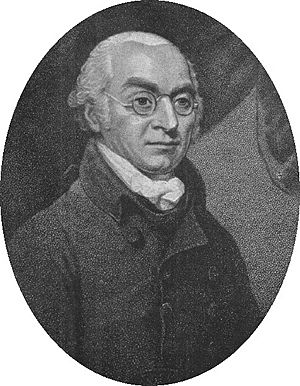James Ware (ophthalmologist) facts for kids
Quick facts for kids
James Ware
|
|
|---|---|

portrait by Mather Brown
|
|
| Born | 11 February 1756 |
| Died | 13 April 1815 (aged 59) |
| Occupation | Physician |
| Years active | 1791 - 1815 |
| Known for | Eye surgeon, and Fellow of Royal Society |
James Ware (1756–1815) was a famous English eye surgeon. He worked in London a long time ago, during a period called the Georgian era. Many people see him as one of the main people who helped create modern ophthalmology (the study of eyes and eye diseases) in Britain. He was also a member of the important Royal Society.
Contents
Early Life and Training
James Ware was born on February 11, 1756, in Portsmouth, England. His father, Martin Ware, was a master shipbuilder for the royal navy.
James went to grammar school in Portsmouth. When he was about 14, he started learning to be a surgeon. He became an apprentice to Dr. Ramsay Karr, a surgeon at the King's Yard in Portsmouth. During this time, he also helped surgeons at the Haslar Naval Hospital. He assisted with treating many accidents that happened often in the shipyards.
After his apprenticeship, James moved to London. In 1773, he became a student at St. Thomas' Hospital. He learned so much that in 1776, he was chosen to teach anatomy (the study of the body's structure) to other medical students.
Becoming an Eye Doctor
In London, James Ware met Jonathan Wathen. Wathen was a well-known surgeon who focused on eye diseases. Ware became Wathen's assistant in 1777. Soon after, in 1778, he became a junior partner in Wathen's medical practice.
This partnership was very good for both doctors. It lasted until 1791, when James Ware started his own practice. Wathen then took on his grandson, Jonathan Wathen Phipps, as his new partner. Phipps later became the eye doctor for King George III and King William IV. He was even knighted for his service.
Wathen, Ware, and Phipps were the top eye doctors in London during the late Georgian era. They are famous for changing eye care. Before them, many people who claimed to be eye doctors were not properly trained. These three doctors helped turn eye surgery into a respected part of modern medicine.
Helping Others and Gaining Recognition
James Ware also helped start important organizations. In 1788, he helped create the Society for the Relief of the Widows and Orphans of Medical Men. This group helped families of doctors who had passed away. He became its president in 1809.
In 1800, he also helped found the School for the Indigent Blind. This school helped people who could not see. It was inspired by a similar school in Liverpool.
Ware was recognized for his important work. In 1798, he became a member of the Society of Antiquaries of London. This society studies history and old objects. In 1802, he was elected a Fellow of the Royal Society. This was a big deal because he was the first eye doctor to join this very important scientific group. This helped eye surgery be seen as a true science.
Family and Legacy
James Ware married Ursula Maitland in 1787. They had eight children, and six of them lived to be adults. Two of his sons, Martin Ware (1789-1872) and John Ware, also became eye doctors. Martin even edited some of his father's medical writings.
James Ware passed away on April 13, 1815, at his home in Chiswick, London. He was 59 years old. He is buried in a family tomb at Bunhill Fields in London. This tomb is now a special historic building in Britain.
A painting of James Ware by Mather Brown was made into an engraving. This picture appeared in a book about Ware and in a magazine after he died.

